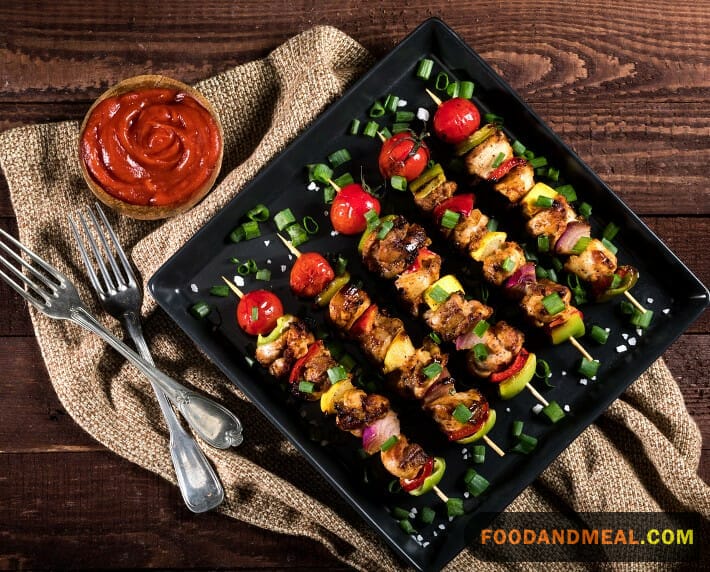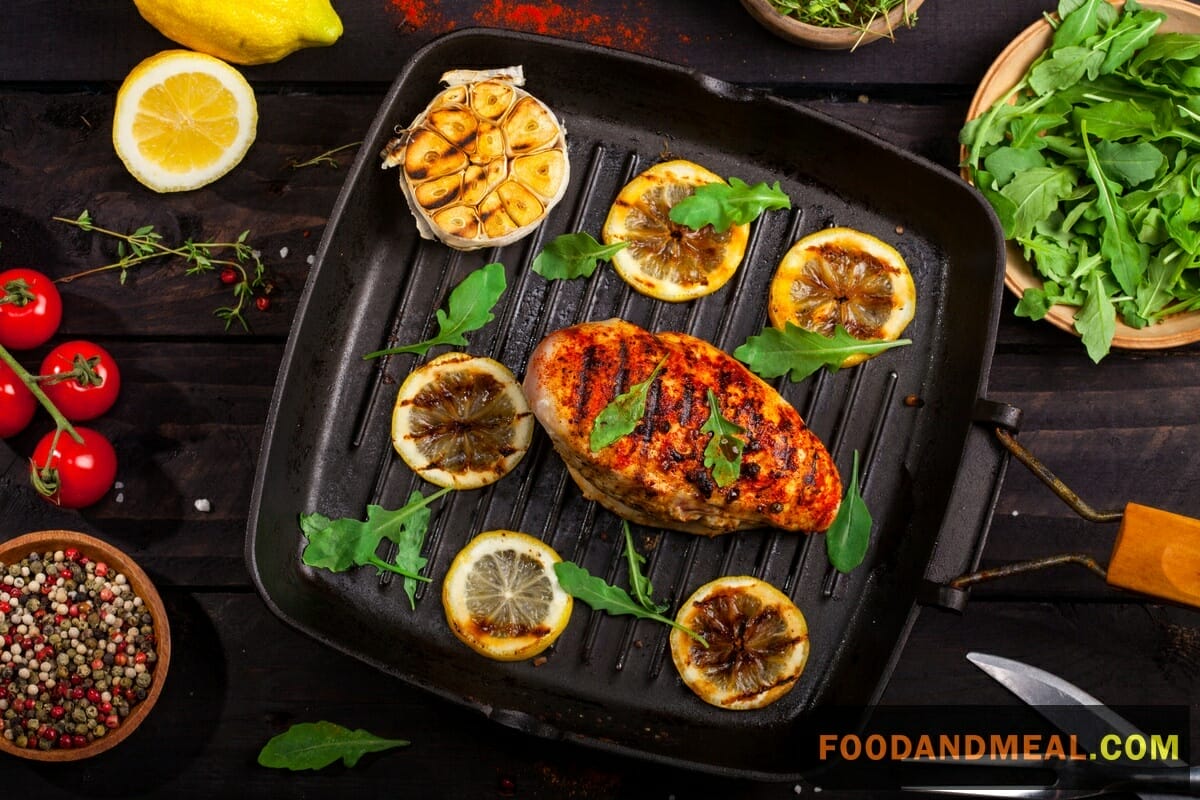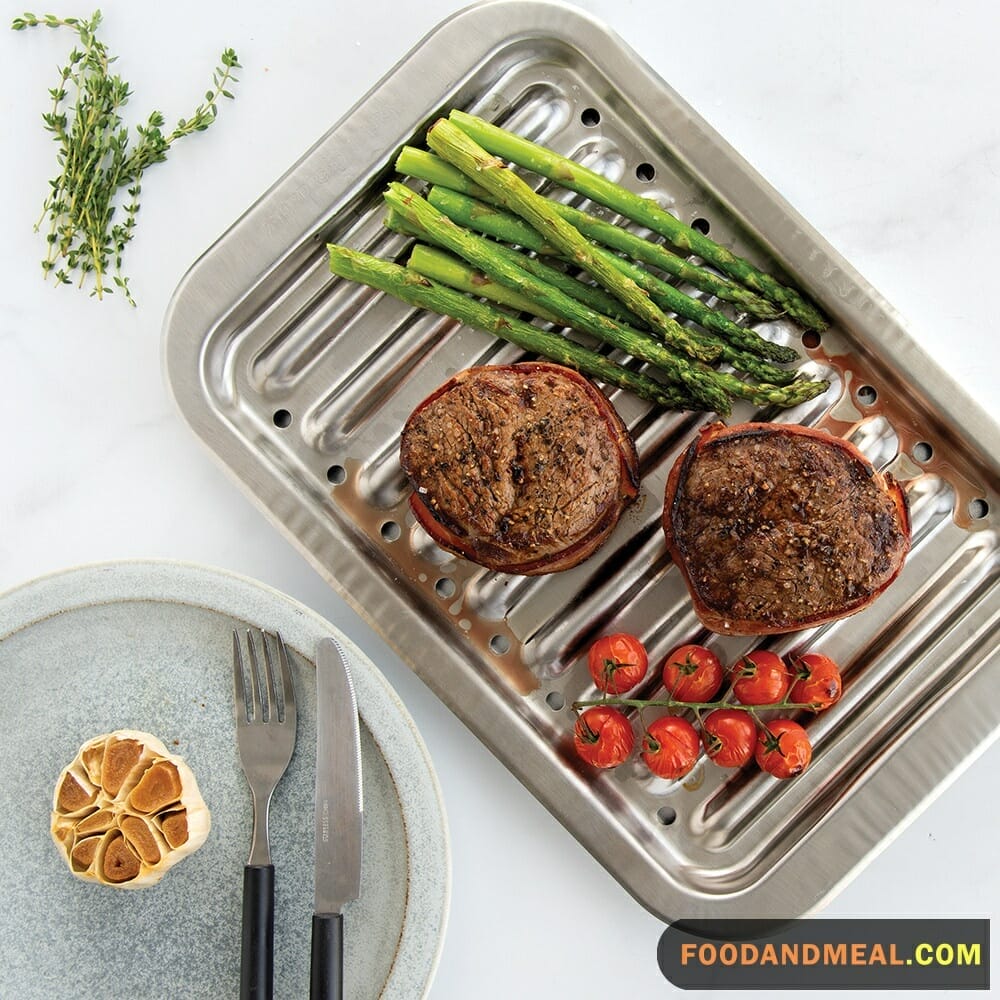Derived from the culinary realm, a broiler pan, also known as a broiler roaster or oven broiling pan, is a vital tool for broiling foods like vegetables, steaks, and meats. Constructed from materials like aluminum and cast iron, this cookware piece is integral to the kitchen.
Nonetheless, despite some shared traits, such as oven use and a rectangular shape, a broiler pan differs from a roasting pan. Here, Food and Meal outline the features of a broiler pan and offer tips for its proper use and upkeep.
Why You Should Broil Your Foods
Often, individuals mistakenly equate broiling with roasting; however, they are distinct cooking techniques. Broiling involves applying dry, direct heat to prepare solid foods like meats and vegetables. This method places the food directly beneath the heat source.
Broiling can also be employed to lend a caramelized consistency to items previously cooked using alternate methods. Due to its swift, high-temperature cooking, broiling efficiently melts fats and imparts abundant flavors. Several benefits of broiling foods encompass:
Cooks Food Faster
Contrary to popular belief, broiling employs dry, intense heat which results in quicker cooking. For instance, a piece of chicken or meat can be broiled to perfection in under 15 minutes.
To prevent overcooking and charring, it’s recommended to frequently monitor the cooking progress or set a timer. Moreover, the process of broiling is straightforward. Many ovens come equipped with dedicated broiler compartments, simplifying the broiling process. In essence, broiling stands as a convenient and efficient cooking method.

Uses Less Fat
Minimal to no oil is required for broiling, given the proximity of the food to the heat source. This aspect renders broiling a health-conscious cooking method by minimizing excessive fat in your meals. For instance, the inherent fat in fatty foods such as red meat tends to liquefy and drain from the broiling rack into the pan, contributing positively to heart health.
Furthermore, broiling bestows tenderness upon the food, accompanied by a flavorful, well-browned exterior. Enhancing the aromatic profile of your dish can be achieved by coating it with a blend of herbs and spices. To prevent unwanted smoking during broiling, it’s advisable to trim any excess fat from the food prior to cooking.
Provides Different Textures
Furthermore, broiling offers the opportunity to attain diverse textures in your dishes. Whether you’re aiming for a caramelized, crispy, or crusty outcome, broiling facilitates these transformations. Moreover, it imparts distinctive and intricate flavors to your food. It’s important to select foods that are naturally tender and capable of withstanding high heat when opting for broiling.
What is a Broiler Pan?
A broiler pan serves as a dedicated oven accessory tailored for the broiling process. This pan consists of two components: an upper pan with slots and a deeper lower pan known as a drip pan. Broiling involves subjecting food, like meats, to exceedingly high temperatures using direct heat, predominantly from the top rather than the bottom.
Why You Should Use A Broiler Pan
Distinguishing a broiler pan is straightforward based on its distinct attributes. Typically comprised of two components—a top and a bottom pan—this culinary tool exhibits specific traits. The upper pan features perforations that facilitate airflow and function as outlets for excess fat and moisture.
Conversely, the lower pan is purposefully crafted to accumulate fat drippings from the upper pan. As a result, the fat content drains away, setting it apart from roasting pans that retain food fat during the cooking process. A well-suited broiler pan should possess ample size to accommodate your food while fitting seamlessly onto your broiler tray. Additionally, it should exhibit resilience to endure high temperatures.
Broiler pans are constructed using varied materials such as enameled steel, porcelain, stainless steel, aluminum, and more. The chosen material influences the intended use and maintenance approach for each broiler pan. It’s essential to select the one that aligns with your requirements and can be effortlessly upheld. Here are several compelling reasons to incorporate a broiler pan into your cooking routine:
Available And Affordable
Acquiring a broiler pan is both accessible and cost-effective. These pans come in various sizes and materials, providing a diverse array of choices. They are readily accessible both in brick-and-mortar stores and online marketplaces.
While staying within your budget is important when purchasing a broiler pan, it’s equally essential to avoid compromising on quality. Prior to selecting a specific brand, it’s advisable to verify the manufacturer’s reputation. By conducting thorough research, it’s possible to find high-quality broiler pans even when working with a limited budget.

Healthy Cooking
Utilizing a broiler pan promotes a health-conscious approach to cooking, contributing to an overall healthy lifestyle. It aligns well with a lower-calorie diet by effectively preparing food with minimal or no additional oil. Remarkably, there’s no need to coat the broiler pan with oil or butter prior to cooking.
The inherent fat in the food itself proves sufficient. Furthermore, a broiler pan facilitates swift marination and glazing of your dishes. Any excess fat released from the food can be either preserved for future use or discarded. However, it’s essential to limit broiling to foods that do not require cooking within their own juices.
How To Use A Broiler Pan
Employing a broiler pan is a straightforward process. Typically more robust than baking pans, broiler pans are designed to withstand intense heat without warping. Nevertheless, they are still manageable. The following presents a step-by-step manual for effectively using a broiler pan:
Positioning the Broiler Pan for Optimal Cooking
The broiling racks in your oven are typically situated near the broiling element. Prior to starting the broiling process, ensure that your broiler pan is positioned on the rack, either in the upper or lower slot. The placement of your broiler pan depends on the type of food being broiled.
For example, when preparing thicker cuts of food like steak that require more cooking time, place your broiler pan in the lower position. Conversely, if you’re cooking foods that cook rapidly, such as vegetables or fish fillets, opt for the top rack.
Placing thicker or larger food items too close to the broiler can result in quick browning of the outer layer while the center remains undercooked. Should you choose the upper rack, be vigilant in monitoring your food to prevent overcooking or burning.
Turn On The Broiler
When utilizing your oven for broiling, it’s necessary to initiate the broiling element. Once activated, the element heats up and transforms into a radiant, bright orange color, emitting infrared rays. This heating process typically takes around 10 minutes to complete.
Locate the broiling element either beneath the stovetop or burner, or positioned above or below the oven racks. In cases where your oven lacks an explicit on/off switch for broiling, adjust the oven settings to a high temperature. Additionally, consider leaving the oven door slightly ajar to prevent the oven from automatically shutting off.
Broil Your Food
Initiate the broiler once you’ve turned it on. Given that broiling involves cooking at high heat, your food ought to be prepared in under 15 minutes. Should you surpass this duration, your food risks becoming overly charred.
Nonetheless, thicker food items might necessitate additional time, and occasional flipping could be required to ensure uniform cooking on all sides. When retrieving your cooked food, exercise caution and refrain from positioning your face directly above the oven door to prevent any accidental mishaps.
Tips For Maintaining A Broiler Pan
Proper Storage Techniques for Your Broiler Pan
Ensuring the longevity of your broiler pan involves correct storage post-cleaning. It’s essential to avoid stacking other pans above or beneath your broiler pan. This practice not only poses a threat of scratching the non-stick surface but also carries the potential to deform the pan’s shape. A distorted pan won’t offer the desired level of functionality and durability. To store your broiler pan optimally, consider hanging it or placing it on your stovetop.
Clean The Broiler Pan Immediately After Use
Immediately clean the broiler pan after each use for an easy and stress-free process. This ensures swift removal of any lingering food particles. However, allow the pan to cool before submerging it in water. To eliminate stubborn residue from the pan’s base, options include employing kosher salt and oil, salt and potatoes, or baking soda.
Employ a gentle kitchen detergent and a soft cloth for washing the pan. Many broiler pans feature non-stick coatings that abrasive cleaning agents could harm. If grease buildup is substantial, opt for a rinse with warm water.
As for the appearance of a broiler pan, it typically consists of two main parts: the upper slotted tray, designed to hold the food being broiled, and the lower drip pan, which catches any drippings or excess fats that may come off the food during cooking. The two parts are often detachable for easier cleaning.
Always Preheat The Broiler
Whether you’re preparing delicate or substantial dishes, it’s essential to preheat the broiler before introducing your food to the oven. By doing so, you guarantee that your food initiates the cooking process immediately upon entering the oven. Consequently, this minimizes the duration your broiler pan is subjected to intense heat.
Use The Appropriate Heat
Although broiler pans are designed to endure elevated temperatures, their composition varies, impacting their heat tolerance. For instance, a broiler pan crafted from aluminum can endure higher heat levels compared to one constructed from non-stick substances such as ceramic.
Subjecting a ceramic broiler pan to high heat can compromise its non-stick attributes. As a rule of thumb, it’s recommended to select a medium heat setting when broiling to enhance the longevity of your pan.
Employing a broiler pan promotes health-conscious cooking while infusing your dishes with intricate and distinct flavors. Yet, optimal outcomes hinge upon its correct utilization. For example, neglecting to monitor your food during broiling could lead to its deterioration. Additionally, ensuring the sustained effectiveness of your broiler pan necessitates regular maintenance.
FAQs
- Q: What is a broiler pan?
A: A broiler pan is a cooking utensil specifically designed for use in the broiler section of an oven. It typically consists of a slotted upper pan that allows fats to drip away from the food and a lower pan to catch the drippings.
- Q: How does a broiler pan differ from a baking sheet?
A: A broiler pan has a slotted top that allows fats to drain away during cooking, while a baking sheet is solid. The design of a broiler pan helps to create a seared or grilled effect on the food.
- Q: Can I use a broiler pan in a regular oven?
A: Yes, a broiler pan can be used in a regular oven. It’s specifically designed for broiling, but it can also be utilized for other cooking methods, such as roasting or baking.
- Q: What types of food are suitable for cooking on a broiler pan?
A: Broiler pans are ideal for cooking meats, poultry, fish, and vegetables. The elevated design allows the food to be closer to the broiler element, creating a caramelized and slightly crispy texture.
- Q: Do I need to preheat the broiler pan before using it?
A: Preheating the broiler pan is not necessary. However, it’s advisable to preheat the broiler itself before cooking to ensure even and efficient cooking.
- Q: How do I clean a broiler pan?
A: Allow the broiler pan to cool before cleaning. Remove excess food debris, and then wash it with warm, soapy water. Some broiler pans are dishwasher-safe, but check the manufacturer’s instructions for specific care guidelines.
- Q: Can I use aluminum foil on a broiler pan for easy cleanup?
A: Yes, you can line the top of the broiler pan with aluminum foil for easier cleanup. Make sure the foil is slightly larger than the pan to catch drippings effectively.
- Q: What are the benefits of using a broiler pan?
A: Using a broiler pan allows fats to drain away from the food, resulting in a healthier and slightly seared texture. It’s also an efficient way to cook food quickly under the high heat of the broiler.
- Q: Can I use a broiler pan on a gas grill?
A: While broiler pans are designed for use in ovens, some people use them on gas grills for specific cooking applications. Ensure the pan is heat-resistant, and monitor the cooking process closely.
- Q: Are broiler pans oven-safe at high temperatures?
A: Broiler pans are designed to withstand the high temperatures of the broiler setting in an oven. However, check the manufacturer’s guidelines for specific temperature limits.

25 December ·
Broiler Pan Basics: Your Guide to Cooking Perfection
By Food And Meal
Welcome to another episode of "Culinary Delights Unveiled," where we explore the art and science of cooking. I'm your host, Jenny, and today, we're diving into a topic that might be new to many - "What Is A Broiler Pan And How To Use It". Broiling is a cooking technique that's often misunderstood but can completely transform your meals. Many people mistakenly think of broiling as just another version of roasting, but it's actually quite distinct. With the help of a broiler pan, you can achieve a crispy, caramelized texture that's hard to replicate with other cooking methods. Join me as we uncover why you should consider broiling your foods and how to use a broiler pan effectively to elevate your culinary skills. Get ready to unravel the mysteries of the broiler pan and step up your cooking game!


